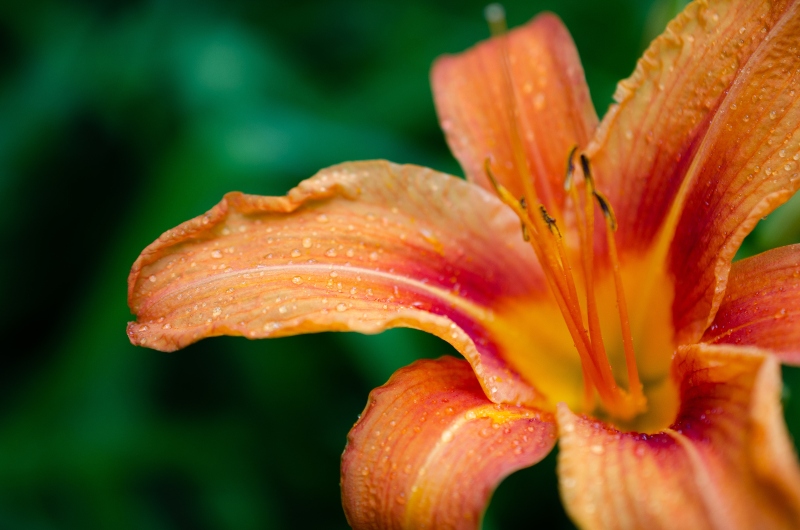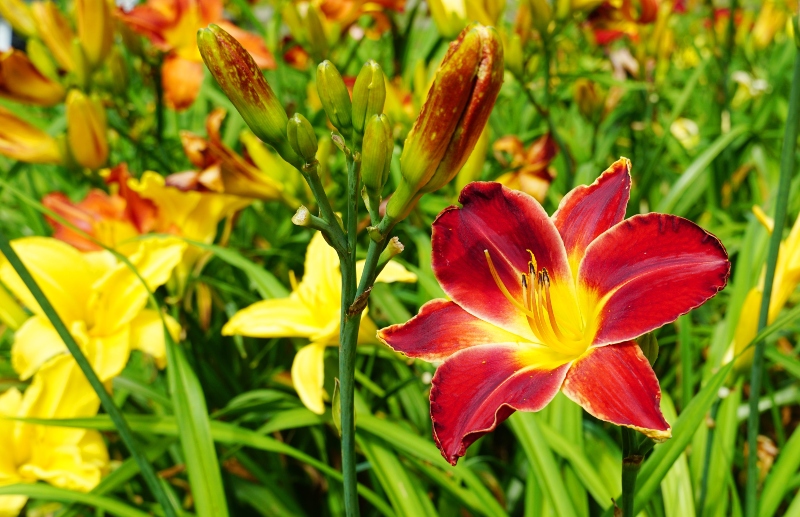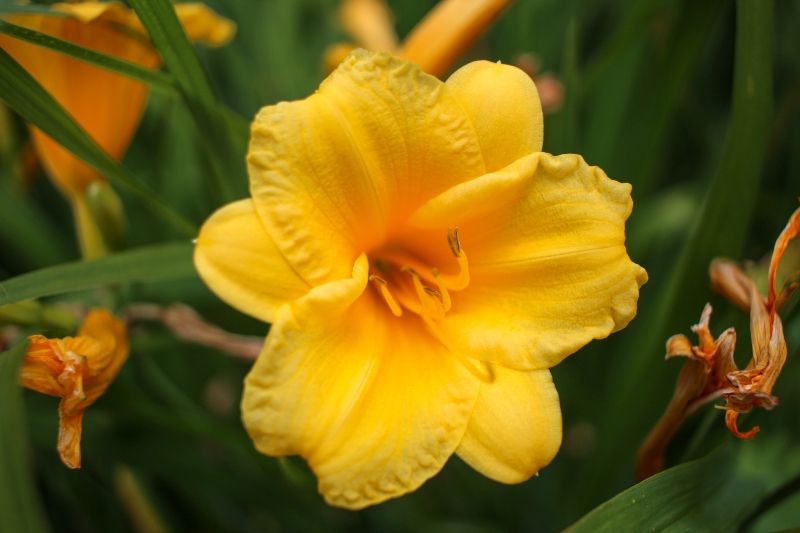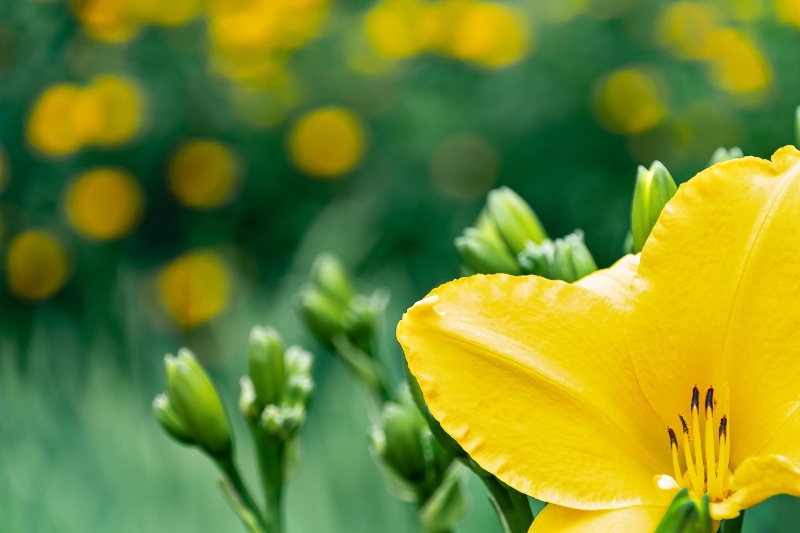Types Of Daylilies You Should Know About

Daylilies are a type of perennial flower popular for their large, colorful flowers. They come in various shapes and sizes and can be used in any garden setting. This article will show you the different types of daylilies according to form, size, color patterns, plant cycle, and bloom time. Read on to learn more!
Table of Contents
Daylilies According to Flower Form
Single Daylilies- One pistil (composed of three carpels) is found in a single daylily flower with three petals, three sepals, six stamens, and one pistil (composed of three carpels) are known as “single” daylilies. Depending on the variety, a single daylily flower may have fewer or more parts per whorl on occasion (see “polymerous”).
Circular Daylilies- these daylily flowers have a lot of petals and are round in shape.
Double Daylilies- Flowers with more than six segments. Like single daylilies, there are many different double daylilies to choose between. To create the illusion of a flower within a flower, ‘Hose-in-Hose’ doubles have extra whorls (layers) of petals. Petaloid (petal-like) stamens are found within the normal petal whorl of ‘Peony type’ doubles. A petaloid carpel has been found.
Recurved Daylilies- The flowers of recurved daylilies have the ends of the segments tucked under them. However, some flower segments roll back or tuck under as they flare out when observed from the side. While a triangular shape is formed when the sepals and petals are both recurved, the opposite occurs when the sepals are only recurved, and the petals are not. If viewed from the side, the rolled-back petals and sepals reveal the recurved form of the flower.
Ruffled Daylilies- flowering daylilies with ruffles along the edges are known as ruffled daylilies.
Star-Shaped Daylilies- flower shapes that look like a three- or six-pointed star can be made by star-shaped daylilies.
Spider Daylilies- these daylilies are distinguished by their narrow, spider-like petals. The tips may be slightly curled. When the length to width ratio of the petals is at least 4 to 1, the flower is called a lily (i.e., 4:1). The length is measured with the segment fully extended. The width of the flower is measured as it naturally grows.
Triangular Daylilies- have flower parts that make a triangle when seen from the front of the flower.
Trumpet Daylilies- When in bloom, trumpet daylilies have trumpet-shaped flowers, making them look like lilies in the garden.

Unusual Form- Daylilies are classified as “unusual forms” because of the unique shapes of their petals or sepals. Crispate (pinched, twisted, or quilled), Cascade, and Spatulate are examples of these shapes. At least three petals or three sepals must display one of these shapes.
- Pinching– folded or pinched floral segments with sharp folds
- Twisting– corkscrew-like or pinwheel-like sections of flowers.
- Quilling– floral segments are twisted around each other to create a tubular shape.
- Cascading/Curling– small, curled-up floral segments that twist and turn like a wood shaving.
- Spatulate – floral segments that are noticeably wider at the end, similar to a spatula in the kitchen.
- Polymerous-A daylily is described as polymerous if it has more segments in each floral whorl than the standard three sepals (usually four or five) in the outer whorl and more petals (usually the same number as sepals) in the inner whorl than the standard three sepals (usually four or five).
Sculpted– Structural features on the petal surfaces originate from the throat, midrib, or elsewhere. Pleated, Cristate, and Relief are the three categories of sculpted forms.
- Pleated– has petals with long, deep creases on both sides of the middle rib. Cures in the petals cause the petals to fold over on top of each other, making a raised platform that goes from the top of the perianth tube to between the throat and the end of the petal.
- Cristate– This group is for flowers with extra petals that grow from the middle of the petals or somewhere else on the petals’ surface. Many people call this “Cresting,” but it can happen on single and double daylilies. This doesn’t make a single daylily into a double one.
- Relief– These are the kinds of daylilies that have ridges that run from the throat to the petal surface, giving them the name “relief.” Depending on how the midrib develops, the ridges may run parallel to the veins or radiate outwards from each end.
Multiform– When a daylily exhibits two or more of the following forms: spider, unusual form, polymerous, or double. A spidery daylily or a polymerous double, for example, is multiform. However, a single spider, for example, is not a multiform.
Flat– Flowers are flat when viewed from the side, except for the concave throat.
Informal– When viewed from the front of the flower, there is no discernible shape to the flower segments. The arrangement of segments may be erratic, dispersed, or floppy.
Tetraploid– These daylilies are tetraploid, meaning they have twice the number of chromosomes as normal. Their flowers are larger than those of the majority of daylilies. Often, colors are more vivid. Scapes, on the other hand, are typically more robust and powerful.
Diploid– Some consider these daylilies to have a more graceful appearance. Diploid species include spiders and double daylilies. Although diploid flowers are typically smaller, they are also more numerous on the plant. Diploids outnumber tetraploids in the daylily family.

Daylilies According to Size
Miniature Daylilies- The flower diameters of miniature daylilies are less than 3 inches.
Small Daylilies- Flowers range from a diameter of 4 ½ inches.
Large Daylilies- Flowers with a diameter of 4 ½ inches and more.
Daylilies According to Height
Low: The scapes range in height from 6 to 24 inches.
Medium: The scapes range in height from 24 to 36 inches.
Tall: It is a tall plant, standing more than 36 inches tall.
Daylilies According to Color Patterns
Self: The flower’s color is consistent throughout. Some flowers have different stamens and throats.
Blend: Two or more colors are combined in a flower.
Polychrome: Three or more colors are mixed in the flower segments.
Bitone: The basic color of the petals and sepals varies in intensity or shade.
Bicolor: Petal and sepal colors differ unlikely.
Eyed or Banded: The blooms have an area between the throat and the tips of the flower that is different or darker in color (a zone). If the zone appears on both the petals and the sepals, it is an Eye. If the zone appears only on the petals, it is a Band. If the zone is barely visible, it is a Halo. If the zone is lighter in color than the rest of the flower, it is a Watermark.
Edged or Picoteed: Depending on how close you look, the edges of the flower parts are either lighter or darker in color.
Midrib: The central vein of each flower segment. Possibly a different shade of color from the rest of the segment.
Diamond Dusting: The flower appears to be covered in gold, silver, or tiny diamonds, giving it a dazzling appearance.
Daylilies According to Plant Cycle
Deciduous- Daylilies flowers prefer to bloom in summer.
Rebloomer: During a single season, these daylilies bloom multiple times.
Everblooming: These daylilies bloom continuously throughout the summer, with little or no time between blooming flushes.
Dormant: As winter approaches, the leaves on these daylilies wither completely.
Evergreen: These daylilies are evergreen, meaning they keep their leaves all year. Evergreen leaves remain green throughout the winter in temperate climates. Generally speaking, evergreen varieties are better suited to USDA zones 8 to 10, but most types can thrive with proper care. Ideally, they’d like to be in full or partial sunlight. Sun exposure in the morning with partial afternoon shade is ideal for most people. Grow in loamy, slightly acidic, well-drained soil with an acidity of 6.0 to 6.5, and you’ll get the best results.
Semi-Evergreen: a mixture of dormancy and greenery, on the other hand. Depending on the local climate, their foliage takes on various forms. This variety of daylily behaves like an evergreen daylily grown in a warm climate but loses its leaves when moved to a colder location.

Daylilies According to Bloom Time
Nocturnal: These daylilies bloom late in the afternoon and continue to bloom throughout the night. The majority of daylilies are only blooming during the day.
Extremely Early (EE): This term refers to weather between March on the coast and early May in the upper Piedmont and mountains.
Early (E): blooming occurs three to five weeks before the blooming peak in the midseason.
Early Midseason (EM) refers to the period between one and three weeks before most cultivars’ bloom peak.
Midseason (M) is the period between May and June on the coast and June to August in the mountains.
Late Midseason (LM): refers to the period between one and three weeks after your garden’s bloom peak.
Late (L): the season is defined as four to six weeks after the peak of the growing season.
Very Late (VL): These daylilies bloom in the late summer or early fall and are the last to bloom.
